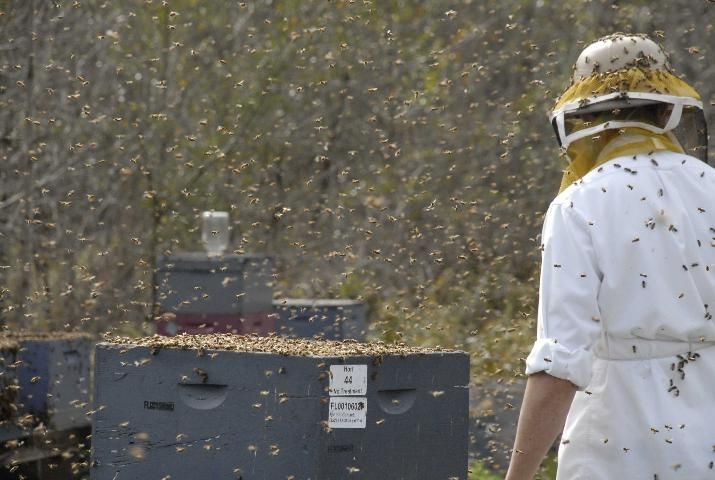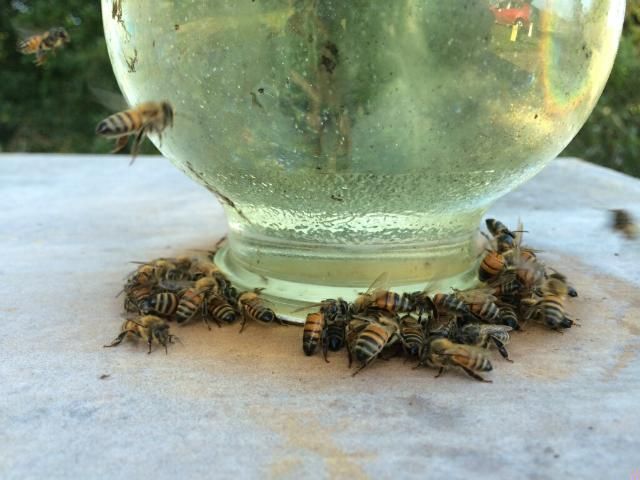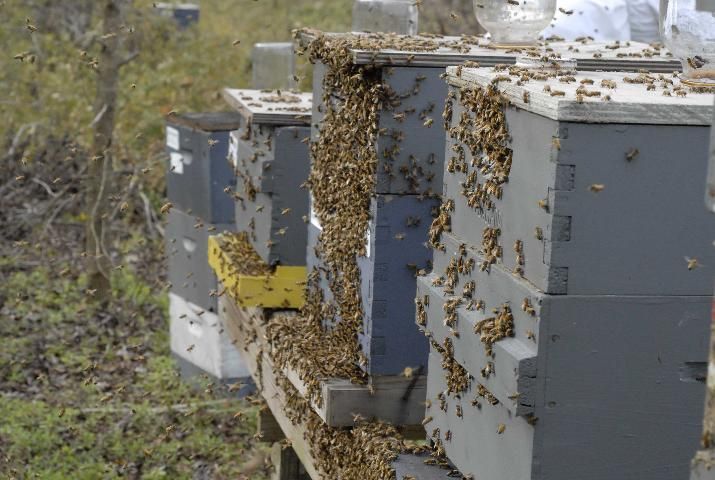What is robbing?
Western honey bee workers can invade and steal honey/nectar from other colonies or sugar/corn syrup from feeders used to deliver syrup to other colonies. This is called "robbing" behavior. Robbing behavior typically involves the collection of nectar and honey, but not pollen or brood. Some beekeepers report that robbing bees may steal wax or propolis from other hives, but not many data are available on this occurrence. Robbing behavior can escalate quickly from just a few bees robbing other colonies to a massive frenzy of bees robbing many colonies in an apiary.

Credit: UF/HBREL
In normal foraging behavior, honey bees gather nectar from blooming flowers in their foraging range and pass the nectar to bees who deposit it into wax cells in the hive. Then, the nectar is processed into honey, capped over with wax, and stored in the hive. Some nectar may be combined with pollen and the resulting product stored as bee bread, a food for the brood and young adult bees in the hive. In beekeeping terminology, a "nectar flow" or "honey flow" is a period when ample local plants are blooming and producing nectar that can be collected by bees. Honey bees are less likely to rob other colonies when nectar is available in the environment.
In contrast, bees are more likely to rob other colonies when nectar resources are scarce. Weak colonies are particularly prone to being robbed because they are unable to defend themselves from the onslaught of invading bees. Robbing can occur between hives in one apiary or between hives in different apiaries. Furthermore, robbing can happen between multiple colonies simultaneously. It is common during a robbing frenzy to see colonies robbing other colonies and being robbed at the same time.
The bees doing the robbing (i.e. "robber bees" or "robbers") typically are older bees that otherwise would be foragers. However, non-foraging bees can become robbers when robbing behavior reaches the frenzy level. Robbing naturally can increase in intensity in a short amount of time as robber bees return to their nest and recruit more robbers from their own hive to join in the behavior.
Robbing can be a major problem in the southern part of the United States, especially during summer or when other major nectar dearths occur. Any apiary can experience robbing at any time of year, although certain situations promote robbing more than do others. In many instances, robbing is caused or exacerbated by the beekeeper's actions.
It is important to note that robbing promotes significant bee drift, or movement of individual bees from their home colonies to other colonies. This increases the risk of transferring pests and diseases between colonies.
When and where does robbing occur?
Robbing occurs throughout daylight hours, usually during a nectar dearth. Colony bee populations grow during nectar flows. The cessation of nectar flows leads to colonies with high populations, many forager bees, and few available nectar resources in the environment. Thus, old forager bees become attracted to weaker hives from which they can steal nectar and honey resources. Weak colonies have proportionately fewer guard bees protecting their entrance and resultantly are more prone to be robbed. It is important to recognize periods of nectar dearth in order to anticipate the initiation of robbing behavior.
Robbing bees may invade other colonies through the nest entrance or through any joints, holes, cracks, or other openings in the hive. Most notably, beekeepers working their colonies during nectar dearths make the colonies vulnerable to robbing bees. Large apiaries with colonies located close to one another are more prone to robbing than are smaller apiaries with fewer, well-spaced colonies. Robbing bees will exploit any sugary resource in proximity to their nest. This includes honey buckets, jars or jugs of sugar syrup, supers left unattended, hives left open or simply not closed properly, honey extraction equipment, and even honey processing rooms or facilities.

Credit: Ashley Mortensen, UF/HBREL

Credit: Ashley Mortensen, UF/HBREL
How to Recognize Robbing Behavior
Beekeepers should learn how to recognize robbing behavior. During robbing events, there typically is an unusually high number of bees flying around the apiary and actively scouting around the outside of nearby colonies. Furthermore, there will be bees fighting at the colony entrance and/or trying to gain entry into the colony through areas where two supers meet and/or around the hive lid and/or bottom board. Colonies in an apiary may have a heightened defensive response, and there often are more dead bees at the colony entrance. There may be remnants of shredded wax cappings or other hive debris near or under the colony or colonies being robbed. This debris may be on the hive bottom board. Bees will continue to rob a source until it is totally depleted. Thus, a colony can be robbed of all of its honey/nectar resources in a matter of hours or days.
How to Stop Robbing When it Occurs
Beekeepers who notice robbing behavior at their colonies should take necessary action to stop the behavior before it escalates into a frenzy.
- Eliminate the stimulus. Bees are attracted to sticky, sugary substances. Remove easy-to-access honey, sugar syrup, refuse combs, etc.
- Close (reassemble) any colonies being worked while robbing is occurring.
- Clean or cover exposed honey or syrup.
- Cover or plug any openings in vulnerable hives with tape, grass, or other materials. These openings can occur between supers on a hive, between the bottom board and hive body, and between the uppermost super and hive lid.
- Reduce the entrance of the colony being robbed. During cooler months, the entrances can be reduced to a point where only 1–5 bees are able to exit/enter at a time.
- Smoking bees is not an effective way to stop robbing behavior.
- Some beekeepers report being able to calm the robbing behavior by running overhead sprinkler irrigation on the colonies being robbed. This discourages the robbing bees, who return to their own colonies.
- If these steps do not reduce robbing behavior, the victim colonies should be removed from the apiary and located elsewhere until they are strong enough to protect themselves.
How to Prevent Robbing
- Maintain queenright colonies of uniform strength and in good equipment.
- Work colonies carefully but quickly during nectar dearths.
- Use an entrance reducer on all colonies during times of nectar dearth.
- Always keep supers covered when removing them to work a colony.
- Do not work more than one colony at a time.
- Remove any excess supers or honey that the bees in a colony are unable to protect.
- Equalize colonies (i.e. take steps to make them similar in strength).
- Move weaker colonies to another location.
- Avoid dripping syrup, nectar, or honey on the outside surfaces of or the ground around hives.
- Work colonies later in the day to reduce the amount of daylight hours bees have to rob.
- When feeding colonies, always keep external feeder surfaces free of syrup and clean up any syrup spills.
- Do not leave wax, honey debris, or combs exposed in the apiary.
Beekeepers should not use chemical repellents at the entrance of a hive to keep robbing bees away. Though the robbing bees may be repelled, bees living in the hive may as well.

Credit: UF/HBREL
Selected References
Downs, S. G and Ratnieks F. L. W. 1999. Adaptive shifts in honey bee (Apis mellifera L.) guarding behavior support predictions of the acceptance threshold model. Behavioral Ecology. doi: 10.1093/beheco/11.3.326.
Mortensen, A.N., D. R. Schmehl, and J. D. Ellis. 2013. Apis mellifera Linnaeus, and subspecies (Insecta: Hymenoptera: Apidae). University of Florida/IFAS Entomology and Nematology Department, Featured Creatures, EENY 568. (29 July 2014).